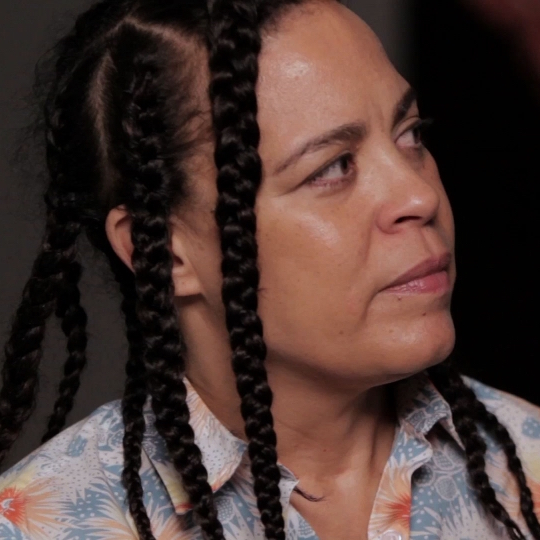Continue playing
(Time remaining: )
Play from beginning
Continue playing "{{ controller.videos[controller.getVideo(controller.currentVideo)].segmentParentTitle}}"
{{controller.videos[controller.getVideo(controller.currentVideo)].title}} has ended.
CuttingEllen Gallagher
Ellen Gallagher discusses the paper cutouts that she’s embedded into paintings throughout her career. Shown at the New Museum, seated in her solo exhibition Don’t Axe Me (2013), she explains how she scrapped away areas of her thickly painted canvases and inlaid black paper birds, leaving their sharply cut edges distinctly visible.
Gallagher traces her interest in cutting to when she first began working with penmanship paper and needed to release air bubbles trapped under its surface. Her fondness for cut paper is most evident in her Watery Ecstatic series (2001–2009), which depicts sea creatures on intricately incised paper.
Credits
Producer: Ian Forster. Consulting Producer: Wesley Miller & Nick Ravich. Interview: Ian Forster. Camera: Rafael Salazar & Ava Wiland. Sound: Ava Wiland. Editor: Morgan Riles. Artwork Courtesy: Ellen Gallagher. Special Thanks: New Museum. Theme Music: Peter Foley.
Art21 Exclusive is supported, in part, by the New York City Department of Cultural Affairs in partnership with the City Council; 21c Museum Hotel, and by individual contributors.
Closed captionsAvailable in English, German, Romanian, Italian, Japanese, Korean, Chinese, Italian
Through the Art21 Translation Project, multilingual audiences from around the globe can contribute translations, making Art21 films more accessible worldwide. Translate this video now.
Interested in showing this film in an exhibition or public screening? To license this video please visit Licensing & Reproduction.
Repetition and revision are central to Ellen Gallagher’s treatment of advertisements that she appropriates from popular magazines like Ebony and Our World. Initially drawn to wig advertisements because of their grid-like structure, she later realized that it was the accompanying language that attracted her. Gallagher began to bring these “narratives” into her paintings—making them function through the characters of the advertisements, as a kind of chart of lost worlds. Although the work has often been interpreted strictly as an examination of race, Gallagher also suggests a more formal reading with respect to materials, processes, and insistences. From afar, the work appears abstract and minimal; upon closer inspection, googly eyes, reconfigured wigs, tongues, and lips of minstrel caricatures multiply in detail.
“It is interesting to see the way content surfaces over time, both in my mind and in the skin of the work.”
Ellen Gallagher
Recycling
Ida Applebroog
Mark Bradford
John Baldessari
Artwork Survey: 2000s
Ellen Gallagher
Ellen Gallagher
Ellen Gallagher


